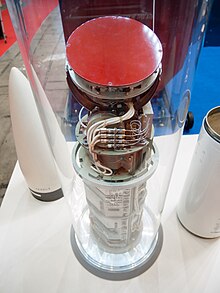

This article includes a list of general references, but it lacks sufficient corresponding inline citations. Please help to improve this article by introducing more precise citations. (October 2007) (Learn how and when to remove this message)
|



Active radar homing (ARH) is a missile guidance method in which a missile contains a radar transceiver (in contrast to semi-active radar homing, which uses only a receiver) and the electronics necessary for it to find and track its target autonomously. The NATO brevity code for an air-to-air active radar homing missile launch is fox three.[1]
There are two major advantages to active radar homing:
Many missiles employing passive homing have an additional capability: if the target does attempt to use noise jamming, the missile can home in on the target's radiation passively (home-on-jam). This gives such missiles improved performance against noise jamming targets and allows anti-aircraft munitions to attack targets they would not otherwise be able to fire on effectively.[citation needed].
Active radar homing is rarely employed as the only guidance method of a missile. It is most often used during the terminal phase of the engagement, mainly because since the radar transceiver has to be small enough to fit inside a missile and has to be powered from batteries, therefore having a relatively low ERP, its range is limited.[2] To overcome this, most such missiles use a combination of command guidance with an inertial navigation system (INS) in order to fly from the launch point until the target is close enough to be detected and tracked by the missile. The missile therefore requires guidance updates via a datalink from the launching platform up until this point, in case the target is maneuvering, otherwise the missile may get to the projected interception point and find that the target is not there. Sometimes the launching platform (especially if it is an aircraft) may be in danger while continuing to guide the missile in this way until it 'goes active'; In this case it may turn around and leave it to luck that the target ends up in the projected "acquisition basket" when the missile goes active. It is possible for a system other than the launching platform to provide guidance to the missile before it switches its radar on; This may be other, similar fighter aircraft or perhaps an AWACS.
Most anti-ship missiles use active radar homing for terminal guidance.
Many ARH missiles with targets on land or sea use millimeter wave guidance.
Examples of missiles known to use active radar homing (all in their terminal phase) include: